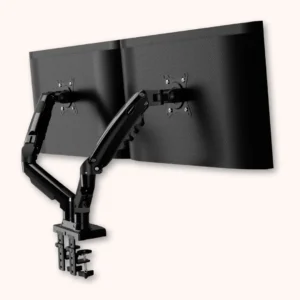When you work from home, your desk setup can make or break your day.
The right home office setup keeps you energized, focused, and comfortable—but the wrong one? Cue back pain, slouching, and that dreaded mid-afternoon productivity crash.
PIN FOR LATER 📌

That’s why so many people are asking the same question: should I stick with a traditional desk and good office chair, or join the standing desk movement that seems to be everywhere (thanks to TikTok)?
Let’s break down both options—what they do well, where they fall short, and how to know which one makes sense for you.
The Case for Traditional Desks
Traditional desks aren’t outdated—they’re reliable. Most of us grew up studying or working at them, so there’s comfort in the familiarity.
Paired with an ergonomic office chair, a monitor stand (or monitor arm if you want to get fancy), and good posture, they can absolutely support long workdays.
Why traditional desks still work:
- Comfort first: Sitting lets you settle in for tasks that require deep concentration.
- Better for small spaces: Many minimal desk setups are slim and stylish, making them perfect for apartments.
- Budget-friendly: A standard desk is often more affordable than an adjustable standing desk.
- Easy to style: From a chic desk mat to cable management clips, traditional setups are flexible and renter-friendly.
The downside? Too much sitting can leave you stiff, sluggish, and mentally foggy by the end of the day.
EVERYONE’S CLICKING ON:
The Case for Standing Desks
Standing desks have gone from corporate-office novelty to mainstream must-have.
The idea is simple: by alternating between sitting and standing, you move more throughout the day, which supports better posture, circulation, and energy levels.
Benefits of a standing desk:
- Boosts energy: Standing can help reduce the “afternoon slump.”
- Encourages movement: Easier to stretch, shift weight, and stay active.
- Ergonomic variety: Breaks up hours of static sitting.
- Long-term health perks: May reduce risks linked to prolonged sitting.
Pairing a standing desk with accessories like a desk mat (to ease pressure on your feet), a monitor light bar (for screen-friendly task lighting), or a dual monitor setup makes the experience even better.
But standing all day isn’t the answer either—it can cause its own strain if you don’t balance it with sitting.
The TikTok Effect: Viral Standing Desks
If you’ve scrolled through your FYP recently, you’ve probably seen “viral” standing desks all over TikTok Shop.
One popular model—the SweetFurniture Electric Height Adjustable Desk—blew up thanks to its sleek design and surprisingly low price.
However, I came across a thread in the r/standingdesk subreddit where users pointed out some serious drawbacks.
As one commenter put it:
Comment
byu/TehAceOfSwords from discussion
inStandingDesk
In other words, what looks sleek in a 30-second TikTok might not actually serve you well day to day!
If you’re considering a standing desk, look beyond the viral hype and pay attention to specs like height range, weight capacity, and build quality.
A Hybrid Approach
Need more than a traditional desk, but not ready to commit to a full standing desk? A hybrid solution might be the sweet spot.
Standing desk converters, monitor risers, and monitor mounts let you elevate your screen without replacing your entire desk.
Here’s Our Favorites
They’re especially great for small home office setups or studio apartments where space is tight.
Add in smart cable management, a cozy office chair, and a minimal desk setup, and you’ll get the ergonomic benefits of standing without the overhaul.
So, Which Is Best for Productivity?
The honest answer: it depends on you.
- If you’re easily distracted or find yourself slouching, a standing desk might boost your focus and energy.
- If you value comfort, have limited space, or prefer to work in longer stretches, a traditional desk with ergonomic upgrades will serve you well.
- And if you’re somewhere in between? A hybrid desk setup—sitting part of the day, standing the rest—is often the most sustainable option.
A desk isn’t just furniture—it’s the heart of your work-from-home life.
Whether you stick with a traditional setup or invest in a standing desk, the key is making intentional choices: a supportive chair, a clean desk mat, smart cable management, and the right monitor stand or mount.
Because when your workspace works for you, your productivity (and your sanity) get a major upgrade.










